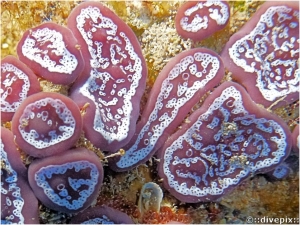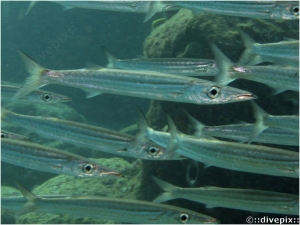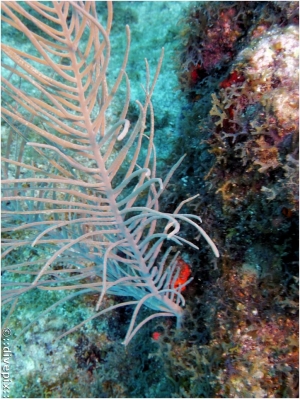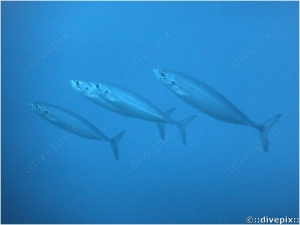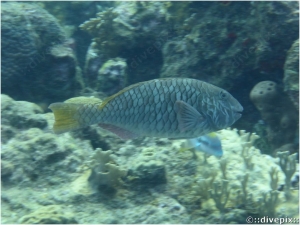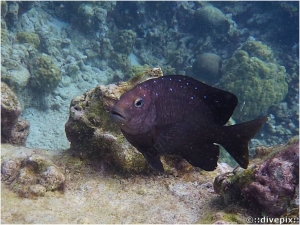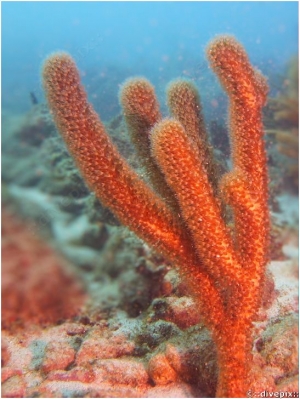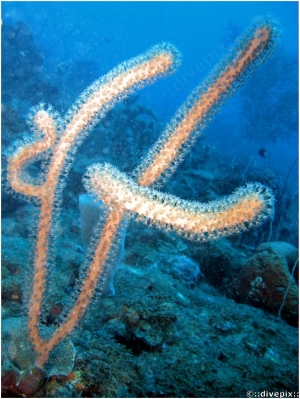




Eric H. Biass
Botrylloides spp. (maroon variety)
| Aspect: | Thin (1 to 3mm) maroon to violet encrusting rubbery cushion of variable size and shape homes white-ish strings of small zooids that form a colony. Up to a score of such patches (seldom exceeding 3cm in length or diameter) can be found clustered on small rocky areas. A very close macro shot below helps to understand the filiation of this formation with tunicates: the white zooids with their individual bucal siphons (in which the bucal cirri can be seen) are arranged within the violet tunic, but use a larger, plain, common outflow opening. |
| Population: | Used to be rare around Ilets Pigeon, but has spread rapidly during the past few years. |
| Notable feature: | Remark: To our knowledge, this maroon variety of botrylloides - a form of tunicate colonies - does not seem to have been described to date and so far appears to have only been seen in the vicinity of Ilets Pigeon. |
| Environment: | Rocky substrates at depths of a few metres down to 42 metres. |
| Behaviour: | - |
Southern Sennet
| Aspect: | Elongated silvery body, slender head featuring long jaws with the lower one extending well beyond the upper one. Apart from smaller size, and despite belonging to the Barracuda family (Sphyraena) looks quite different: no conspicuous body markings and entirely different tail fin shape. |
| Population: | Regularly abundant, but difficult to see (read "Behaviour" below). |
| Notable feature: |
As pictures herewith show, live in largely polarised schools. Very pale longitudinal lines or markings. Leading edge of upper tail fin slightly darker. Remark: strangely called "bécune" in French, which is the local Creole name for the Great Barracuda. |
| Environment: | Usually found in relatively shallow waters. |
| Behaviour: | Shy, schools often keep distant and therefore difficult to properly photograph |
Atlantic Mushroom Coral
| Aspect: |
Like most disc corals featured here, the Atlantic Mushroom Coral is solitary. As the photographs herewith show, it has a rough, bumpy surface. Usually green and brown. With diameters that can reach 18 centimetres, it is the largest of the disc corals. The masked gobie (typically 3cm long) on the right edge of the coral shown in one of the photos below provides a scale. |
| Population: | Common. |
| Notable feature: | CAUTION: Although there are three distinct species of such small disc-shaped coral in the area - Artichoke Coral or Scolymia cubensis, Solitary Disc Coral or Scolymia wellsi, and Atlantic Mushroom Coral or Scloymia lacera - which can only be differentiated with certainty by a microscopic observation of their corallite structure (and more particularly the shape of the tip of their septa). However, if a specimen boasts a diametre of more than 10 cm, chances are that it is an Atlantic Mushroom Coral. |
| Environment: | Against rocky slopes at relatively marked depths - at least 20 metres. |
| Behaviour: | - |
Bipinnate Sea Plume
| Aspect: | Colonies tend to grow along in single stems (unlike other Sea Plumes that grow into more bushy formations). Both stem and branches are also more rigid in appearance and do not droop. |
| Population: | Common. |
| Notable feature: | Pink or pale violet/mauve. Bipinnate means that branches grow from the same point on the stem. They also grow in a single plane. |
| Environment: | Rocky/sandy bottom, typically at depths of 5 to 20 metres. |
| Behaviour: | Whenever exposed, the small polyps immediately retract if touched. |
Rosy Blenny
| Aspect: | Male (seen here): upper half body is brownish with lighter irregular lighter bars. Belly and lower head mottled white and red, with red dots surrounding the eyes. |
| Population: | Not common, but difficult to spot. |
| Notable feature: | Red-spots around the eyes. |
| Environment: | Recesses in or under rocks or boulders on sandy bottom. |
| Behaviour: | Not too shy. |
Mackerel Scad
| Aspect: | Fast swimmer with shiny, elongated silver body with thin, deep-cut V tail. |
| Population: | More common than expected because very stealthy and difficult to spot because it largely reflects environmental colours. |
| Notable feature: | Very distinctive black spot at top of the gill area. Lightly serrated scute at rear body centerline. |
| Environment: | In schools above reefs and along rocky edges. |
| Behaviour: | Always remain away from swimmers and divers. |
Yellowtail Parrotfish
| Aspect: | All parrotfishes sport a strong elongated oval body boasting large scales, prominent mouth with bill-like frontal teeth (hence the name) with which they bite away at coral. |
| Population: | Rare. |
| Notable feature: |
Terminal (adult) phase seen here: generally dull green-grey body, but slightly more stubby snout than other parrotfishes. As latin designation suggests (rubripinne = red finned) fins should be red, but in fact only the pelvic and anal ones are - and yet in a very pale shade. The main identifying feature of the species remains its massive grey pale green livery with yellow-ish tail fin. |
| Environment: | Swims around rocks and coral boulders from which it violently bites off algae and coral. |
| Behaviour: | Can be slowly and quietly approached to about one metre. |
Beaugregory
| Aspect: | All Damselfishes have similar outlines, but with more or less deeply pronounced "chin-pectoral" area and dorsal fin tips of various shapes. |
| Population: | Not as abundant as other Damselfishes. |
| Notable feature: | Difficult to distinguish it from the Longfin Damselfish, but is the only one to sometimes sport blue spots, like the young/adult Yellowtail Damselfish (q.v.). |
| Environment: | Rocky areas, coral boulders. |
| Behaviour: | Can be approached (except juvenile), curious, but constantly moves. |
Slit-pore Sea Rods
| Aspect: | Many branches grow off a main stem, and each branch can carry several others, unlike the Giant Slit-pore Sea Rod. Otherwise, and except for their shorter overall size, Slit-pore Sea Rods are very similar, with similar polyps merely leaving a slit on the surface of their branch when they retract. |
| Population: | Common. |
| Notable feature: | Like the taller Giant Slit-pore Sea Rod (q.v.) the lightly fluted polyps "stems" grow straight from the branch surface, almost sans calyx. The latter feature a slit when the polyp is retracted. |
| Environment: | Like most sea rods, Slit-pore Sea Rods generally grow on even rocky or sandy substrates, starting from depths of 5 metres, down to 30 metres. |
| Behaviour: | - |
Giant Slit-pore Sea Rod
| Aspect: | Amongst the numerous sea rods species, the Giant Slit-pore Sea Rod literally stands head and shoulders above the others height-wise. Secondly, it carries few dichotomous branches, the tips of which tend to enlarge. Slit pore sea rods are thus called because of the slit on small the mounds left on the surface of the branch when polyps retract. |
| Population: | Common. |
| Notable feature: | Like the shorter Slit-pore Sea Rods (q.v.) the lightly splined polyps "stems" grow straight out of the branch almost sans calyx. The latter feature a slit when the poly is retracted. |
| Environment: | Like most sea rods, Giant Slit-pore Sea Rods generally grow on even rocky or sandy substrates, starting from depths of 5 metres, down to 30 metres. |
| Behaviour: | - |



